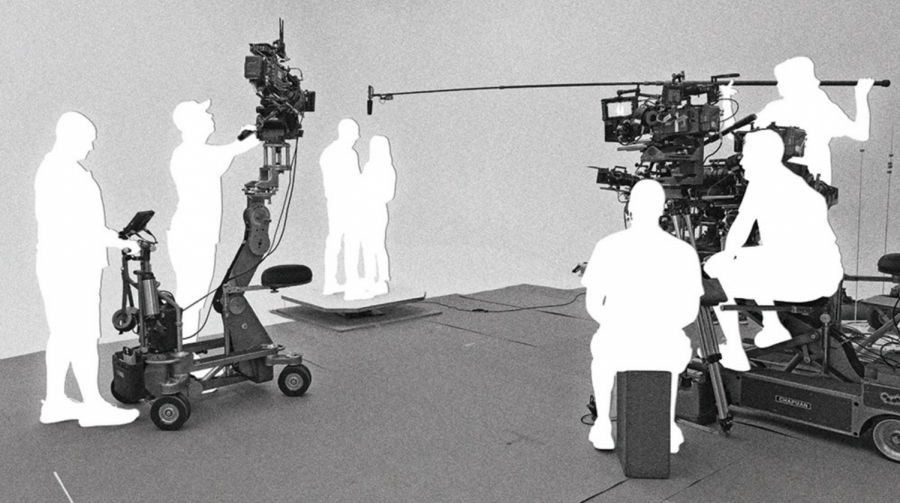Resilience Among the Rubbles of Art Industries
February 7, 2021
On March 13, 2020, the Hunterdon Central drama department planned to host the first general admission show for the musical Evita. The actors spent months learning the music and choreographing the show, pit orchestra members spent countless nights mastering their instruments, and the stage crew spent an immense amount of time building and decorating the sets. However, on the day of the planned production, the show was canceled due to the emerging threat of COVID-19. The efforts of the actors, musicians, set-builders, and teachers were ended abruptly due to the pandemic.
Because Hunterdon Central’s Evita production was organized by high school students, the purpose of the show was not monetary gain. However, the majority of individuals who work in the performing arts industry as a full-time career have been unemployed since March 13, 2020. Artists are not considered essential workers, and thus, for thousands of Americans, careers were halted, and many suddenly lacked the means to earn stable pay.
For many actors and singers, the most challenging part of lockdown was the absence of live performances. While there were some sparse live events, each had heavily enforced social distancing and were forced to be conducted outside. Musician and YouTuber Adam Neely talks about his experience performing one concert during the quarantine–the full band was unable to practice and had to constantly check for symptoms, and attendants had to social distance by staying in marked circles, which were spread out six feet apart. Neely said, “when you have a bunch of people physically in the same place, close to one another, you have a different kind of music.” The lack of live tours also leads to a decrease in the amount of money venues and bands earn. The performing arts industry is estimated to lose over 9 billion dollars in revenue in the coming years.
Due to the absence of live events, virtual concerts began to gain popularity. Artists would “perform” as they would in concert, but rather than audience members being in the same room, they would attend the event virtually. Billie Ellish, who topped charts with her album WHEN WE ALL FALL ASLEEP, WHERE DO WE GO, and more specifically her massive hit “Bad Guy,” performed a virtual concert on Saturday, October 24, 2020. She performed several of her songs, replacing the in-person experience with LED lights and massive surrounding screen walls to display effects that would have been harder to execute in person. The band AJR, most famous for their massive hit, “Bang!” also performed a virtual concert recently. They used wires and sets to create more theatrical moments that would be almost impossible to recreate in person. AJR also held a socially distanced concert, which they performed in Citizen Bank Park, where everyone viewed the event from their cars while they performed on stage, social distancing.
On the other hand, musicians who were once hired to perform live music in clubs or restaurants were forced to find other jobs to earn a living during quarantine. A similar fate occurred to those who worked in live theater. Similar to Hunterdon Central’s Evita, shows were forced to shut down suddenly. Musicals didn’t end up doing virtual performances, as it’s the live aspect of the show that makes it work. Unless the shows were already popular before the pandemic, such as Hamilton or Dear Evan Hanson, they most likely will not be able to reopen when the theater industry returns to a new normal due to an extended period of revenue loss.
Film actors face a slightly different fate. While the production on most shows was shut down, the media continued to produce a plethora of television content. An example of this was the Parks and Recreation quarantine special. A unique production method was used in which each actor was recorded separately. These segments were then edited together to complete the episode. Saturday Night Live adopted a similar method, in which the sketches were altered to be performed separately by each cast member at their own homes.
However, in recent months, television and movie producers have gradually returned for live filming. SNL is back to its normal production format, and the actors are standing on sets close together. Brooklyn 99, another comedy series, is also returning to in-person filming. The creators of the movie Mission: Impossible will also resume in-person work. This will be accomplished by performing rapid COVID testing on every person working on the show or movie every day before they enter their respective sound studios. This way, in the event that someone tests positive, the leadership could immediately stop production on the set. From there, they trust that the actors and workers will quarantine themselves so that they won’t receive the virus from others.
With the distribution of the COVID-19 vaccine beginning earlier this month, the world hopes for a bit more normalcy. Actors, musicians, and all other workers in creative industries will soon be back in a modified full swing, no longer having to navigate around COVID-19 and its restrictions. And while the stadium concerts or massive blockbusters may take their time in returning to normality, the world hopes to experience live events again soon.
